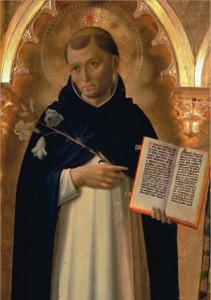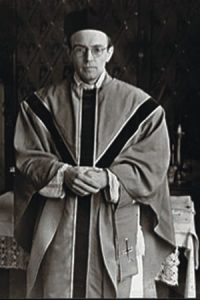August Saints
 Saint Dominic (1170-1221)
Saint Dominic (1170-1221)
Dominic was born at Calaregua, Spain and became an Augustinian canon regular at Osma. In 1206, he founded a convent whose first nuns were converts from the Albigensian heresy. Four years later, he founded the Order of Preachers, whose members relied on the usual religious customs and traditions but provided intellectual pursuits that attracted great scholars.
The Dominican friars were one of the mendicant Orders, alongside the Franciscans, relying on alms for their physical survival, and had a genuine zeal for reaching the common people. Poverty had a great appeal for Dominic and when he died in 1221 he did so in another friar’s bed and another’s habit because he had none of his own.
Saint Dominic, obtain for us an appreciation of the virtue of poverty.
(Source: OSV encyclopedia of saints. Matthew, Margaret & Stephen Bunson. Our Sunday Visitor, Huntington, Indiana. 2003)
 Blessed Karl Leisner (1915-1945)
Blessed Karl Leisner (1915-1945)
Born in Rees/Lower Rhine on 28th February 1915 and growing up in Kleve, Karl Leisner joined the Catholic Youth Movement. This group not only gave him the companionship of young people and experience of trips but also led to a deeper understanding of the Holy Scriptures, the liturgy and above all the Eucharist. Because the Nazis sought to control all work with youth, he had to take teenagers ‘camping’ in Belgium and the Netherlands in order to freely discuss Catholicism.
Karl wanted to become a priest. The Bishop of Münster appointed him the diocesan youth leader. While still a seminarian, he tried to teach catechism to the young, and the Nazis took him out of the seminary and forced him into six months of compulsory labour on agricultural settlements. However, despite Nazi opposition, he organised Sunday Mass attendance for his fellow workers. The Gestapo raided his home and took his diaries and papers. These documents, carefully preserved in Nazi archives, tell how the spiritual young man became a heroic religious leader. On 25th March 1939 he was ordained as a deacon, and was due to be ordained a few months later.
But God had other plans. Tuberculosis was suddenly diagnosed, and forced him to go to the Black Forest for treatment. A criticism of Hitler in 1939 led to his arrest by the Gestapo: prison in Freiburg, then detention in Dachau concentration camp in December 1940.
Here something unexpected happened: already terminally ill, Karl, a German, was ordained in 1944 by a French Bishop during a war in which the two nationalities were in bloody conflict with one another. The Bishop had been secretly admitted to the camp with the help of local religious authorities. The newly ordained priest celebrated his first and only Holy Mass on St. Stephen’s Day, 1944. It would seem that Karl’s whole life had been planned by God for that single Mass he offered at the altar in the Dachau Concentration Camp. His suffering was not in vain, but went on to inspire many with him and after him to persevere in their own suffering, seeing in it the plan of God and knowing that God does great things with the struggles we bear for Him.
He was freed on 4th May 1945 and spent his last weeks in the tuberculosis hospital in Planegg near Munich. Only two thoughts occupied him: love and atonement. On 12th August he saw his life fulfilled in God’s love, which he believed in and which he wanted to preach to all mankind. His last entry in his diary was, “God Almighty, bless my enemies too.”
Karl’s life could be seen as a disaster by worldly standards. But it actually shows and challenges us to see life as God would, with its dignity and special plan for each of us.
Blessed Karl, obtain for us the grace to truly forgive our enemies.
(Source: Internet – various)
 Saint Monica (332-387)
Saint Monica (332-387)
Saint Monica was born of Christian parents in North Africa in 332, and married a pagan husband. He was converted by her gentleness and prayers just before his death, and thenceforward her life was the story of the conversion of her elder son, Augustine, afterwards bishop of Hippo and doctor of the Church.
She followed him to Rome and to Milan, where St Ambrose was her friend and helper. There her prayers and sufferings were rewarded. It was not possible “that the son of such tears should perish”. Monica died at Ostia on the way back to Africa with Augustine in 387.
Saint Monica, teach us to persevere in prayer.
(Source: A new dictionary of saints. Comp. by Donald Attwater. Burns & Oates, Kent 1993)
 Entries(RSS)
Entries(RSS)